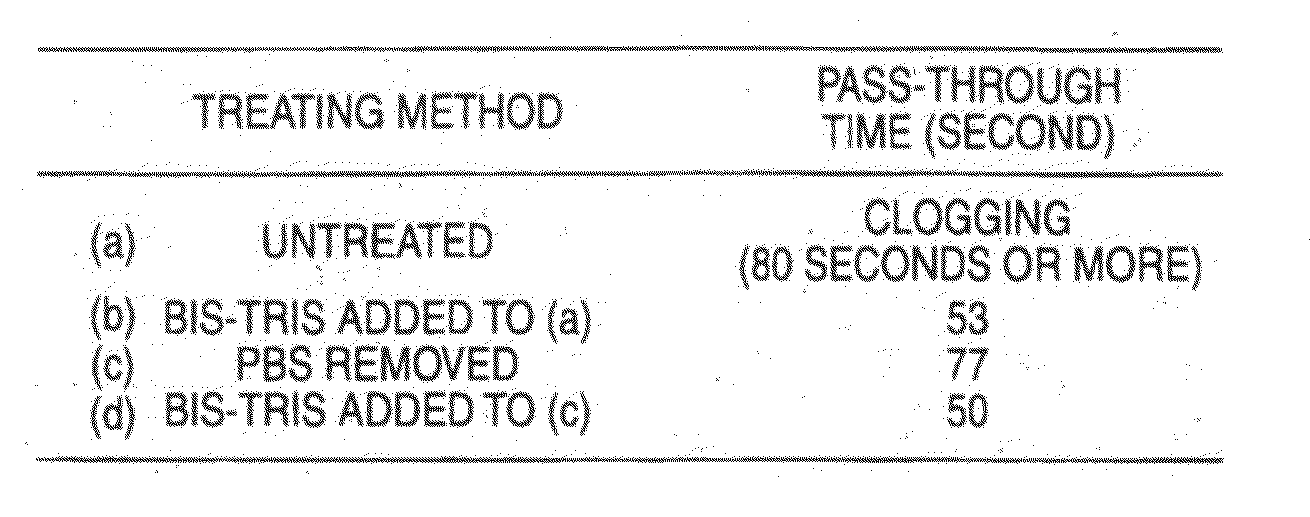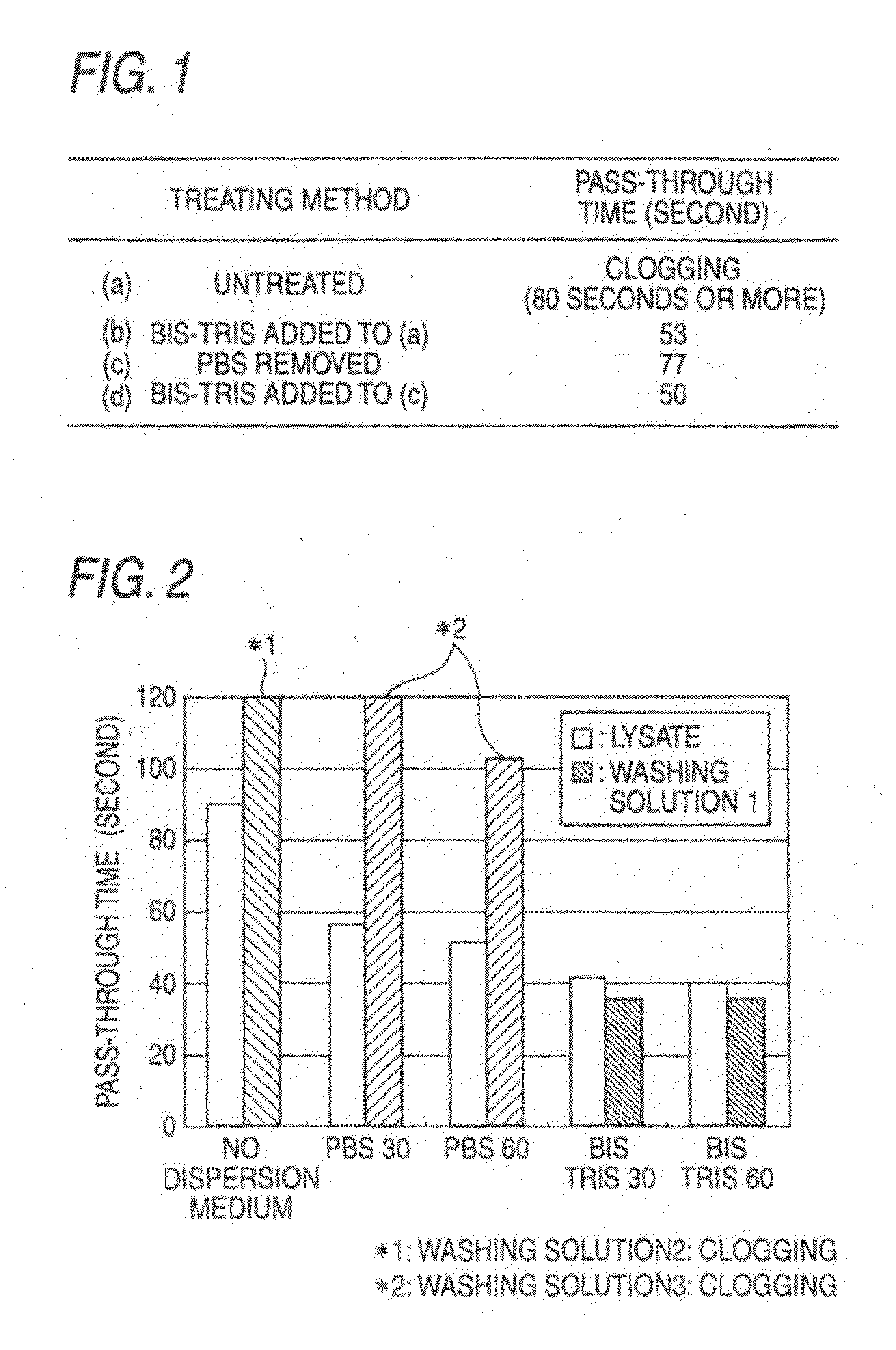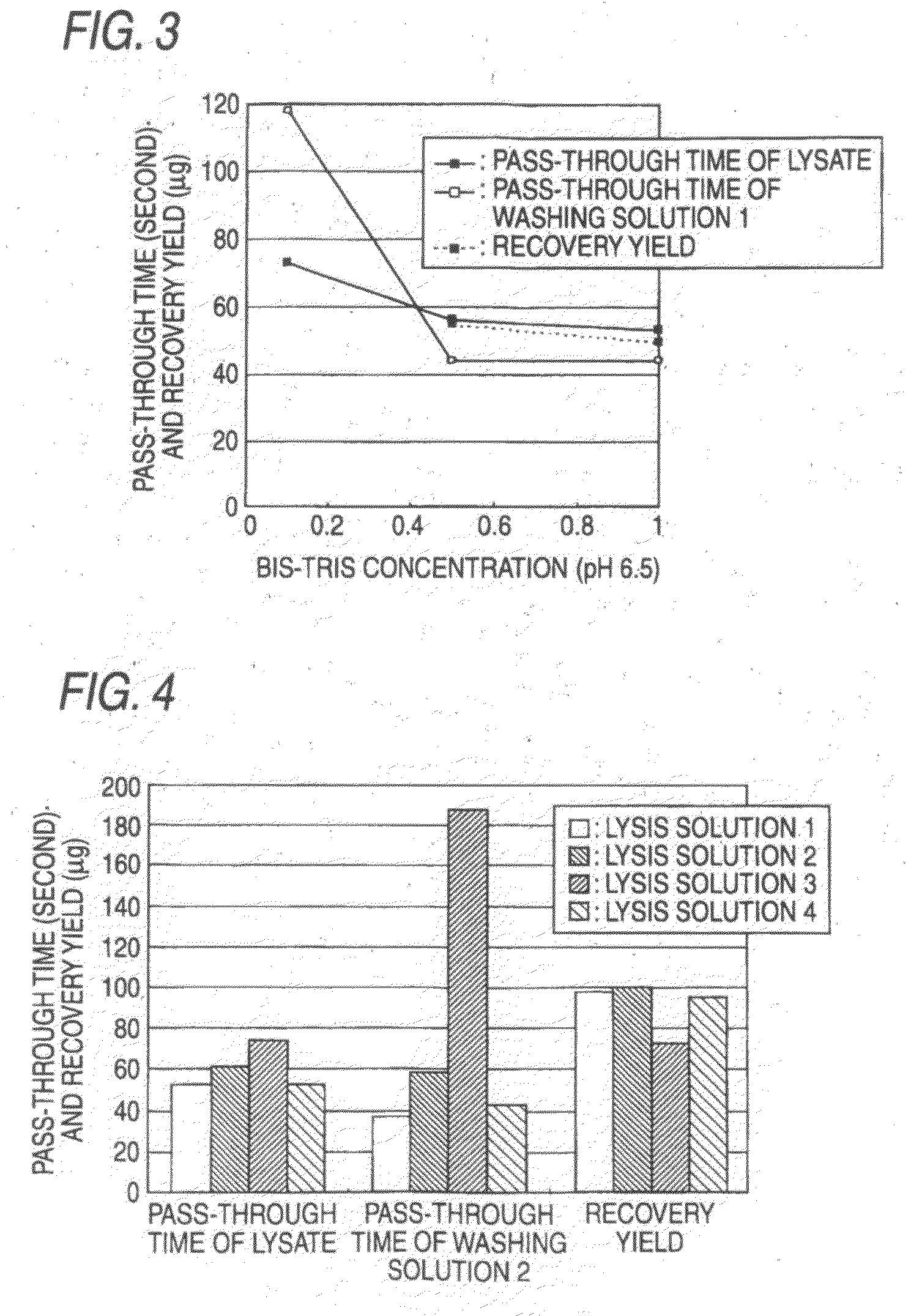Nucleic acid extraction method
a nucleic acid and extraction method technology, applied in the field of nucleic acid extraction methods, can solve the problems of complex operation, large yield and purity, and difficulty in recovering rna with small molecular weight, and achieve the effects of easy processing, excellent separation performance, and good washing efficiency
- Summary
- Abstract
- Description
- Claims
- Application Information
AI Technical Summary
Benefits of technology
Problems solved by technology
Method used
Image
Examples
##ventive example 1
Inventive Example 1
Influence of the Replacement of Dispersion Medium Upon RNA Recovery Yield and Pass-Through Time
[0231]About 10,000,000 cells of pelletized cultured cell HL 60 which had been washed with PBS, centrifuged to remove the washing solution and then cryopreserved were prepared. This pellet contains PBS. The cryopreserved pellet was thawed to carry out the treatments shown in Table 1.
TABLE 1(a) Untreated (pellet was used as such)(b) A 30 μl portion of 0.5 mol / l Bis-Tris (pH 6.5) was added to (a)(c) PBS was removed as many as possible(d) A 30 μl portion of 0.5 mol / l Bis-Tris (pH 6.5) was added to (c)
[0232]In the case of (b) and (d), the cells were dispersed by carrying out pipetting or Vortex treatment. A 610 μl of LR 001 (mfd. by Fuji Photo Film) was added thereto, and immediately thereafter, the pipetting treatment was carried out 5 times. A lysis solution consisting of 3.66 mol / l of guanidine thiocyanate, 1% by volume of 2-mercaptoethanol and 30 μl of ethanol was used. T...
##ventive example 2
Inventive Example 2
Relationship of the Concentration of Dispersion Medium with RNA Recovery Yield and Pass-Through Time
[0241]About 10,000,000 cells of pelletized cultured cell HL 60, which had been cryopreserved, were thawed and mixed with 30 μl of 0.5 mol / l Bis-Tris (pH 6.5), and the cells were dispersed by carrying out pipetting or Vortex treatment. A 490 μl portion of a lysis solution was added thereto. A lysis solution consisting of 5 mol / l of guanidine hydrochloride (GuHCl), 1% by volume of 2-mercaptoethanol and 2.5% by volume of Tween 20 (concentration in the lysis solution) was used. The cells were lysed, subjected to 1 minute of a stirring treatment (2,500 rpm) using CUTE MIXER CM-1000 and then spun down by centrifugation.
[0242]Next, 280 μl of ethanol was added thereto and stirring (2,500 rpm) was carried out for 1 minute using CUTE MIXER CM-1000, spin-down was effected by centrifugation and then a lysate solution was prepared.
[0243]RNA extraction method, calculation of reco...
##ventive example 3
Inventive Example 3
Relationship of the Kinds of Lysis Solution with RNA Recovery Yield and Pass-Through Time
[0246]About 10,000,000 cells of pelletized cultured cell HL 60, which had been cryopreserved, were thawed and mixed with 30 μl of 0.5 mol / l Bis-Tris (pH 6.5), and the cells were dispersed by carrying out pipetting or Vortex treatment. A 540 μl portion of a lysis solution was added thereto in the case of the lysis solutions 1, 3 and 4, or 510 μl of a lysis solution was added thereto in the case of the lysis solution 2, and immediately thereafter, the pipetting was carried out 5 times. Lysis solutions having the compositions shown in Table 2 were used. The cells were lysed, subjected to 1 minute of a stirring treatment (2,500 rpm) using CUTE MIXER CM-1000 and then spun down by centrifugation.
TABLE 21. GTC (3.66 mol / l), ethanol (5.5% by volume)2. RLT (mfd. by Qiagen)3. GuHCl (3.66 mol / l), ethanol (5.5% by volume)4. LR 001 (mfd. by Fuji Photo Film)
All solutions contain 1% by volum...
PUM
| Property | Measurement | Unit |
|---|---|---|
| Time | aaaaa | aaaaa |
| Time | aaaaa | aaaaa |
| Time | aaaaa | aaaaa |
Abstract
Description
Claims
Application Information
 Login to View More
Login to View More - R&D
- Intellectual Property
- Life Sciences
- Materials
- Tech Scout
- Unparalleled Data Quality
- Higher Quality Content
- 60% Fewer Hallucinations
Browse by: Latest US Patents, China's latest patents, Technical Efficacy Thesaurus, Application Domain, Technology Topic, Popular Technical Reports.
© 2025 PatSnap. All rights reserved.Legal|Privacy policy|Modern Slavery Act Transparency Statement|Sitemap|About US| Contact US: help@patsnap.com



